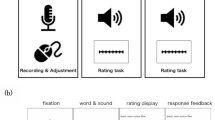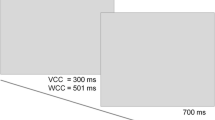Abstract
This study examined the neural processes underlying own voice discrimination using electrophysiological methods. Event-related potentials were recorded while healthy subjects (n = 17) heard passively three oddball sequences composed of recordings of the French vowel/a/pronounced either by the participant her/himself or by two unknown persons. The results indicated that, although the mismatch negativity (MMN) displayed similar peak latency and amplitude in both conditions, the subsequent P3a clearly distinguished the two conditions since its amplitude was significantly smaller for own voice discrimination than for that of unknown voices. Moreover, the own voice discriminative response was associated with an early pre-MMN response. This early response involved a left inferior frontal component, the activity of which lasted throughout the time course of the discriminative response, which included both MMN and P3a.





Similar content being viewed by others
References
Aguera P-E, Jerbi K, Caclin A, Bertrand O (2011) ELAN: a software package for analysis and visualization of MEG, EEG, and LFP signals. Comput Intell Neurosci 2011:158970. doi:10.1155/2011/158970
Alain C, Cortese F, Picton TW (1998) Event-related brain activity associated with auditory pattern processing. NeuroReport 9:3537–3541
Alho K, Sinervo N (1997) Preattentive processing of complex sounds in the human brain. Neurosci Lett 233:33–36
Allen PP, Amaro E, Fu CHY et al (2005) Neural correlates of the misattribution of self-generated speech. Hum Brain Mapp 26:44–53. doi:10.1002/hbm.20120
Aruffo C, Shore DI (2012) Can you McGurk yourself? Self-face and self-voice in audiovisual speech. Psychon Bull Rev 19:66–72. doi:10.3758/s13423-011-0176-8
Beauchemin M, De Beaumont L, Vannasing P et al (2006) Electrophysiological markers of voice familiarity. Eur J Neurosci 23:3081–3086. doi:10.1111/j.1460-9568.2006.04856.x
Belin P (2006) Voice processing in human and non-human primates. Philos Trans R Soc Lond B Biol Sci 361:2091–2107. doi:10.1098/rstb.2006.1933
Belin P, Zatorre RJ, Lafaille P et al (2000) Voice-selective areas in human auditory cortex. Nature 403:309–312. doi:10.1038/35002078
Belin P, Fecteau S, Bédard C (2004) Thinking the voice: neural correlates of voice perception. Trends Cogn Sci (Regul Ed) 8:129–135. doi:10.1016/j.tics.2004.01.008
Blair RC, Karniski W (1993) An alternative method for significance testing of waveform difference potentials. Psychophysiology 30:518–524
Brothers L (1990) The social brain: A project for integrating primate behavior and neurophysiology in a new domain. Concepts Neurosc 1:27–51
Caharel S, Courtay N, Bernard C et al (2005) Familiarity and emotional expression influence an early stage of face processing: an electrophysiological study. Brain Cogn 59:96–100. doi:10.1016/j.bandc.2005.05.005
Cavanna AE, Trimble MR (2006) The precuneus: a review of its functional anatomy and behavioural correlates. Brain 129:564
Charest I, Pernet CR, Rousselet GA et al (2009) Electrophysiological evidence for an early processing of human voices. BMC Neurosci 10:127. doi:10.1186/1471-2202-10-127
Curio G, Neuloh G, Numminen J et al (2000) Speaking modifies voice-evoked activity in the human auditory cortex. Hum Brain Mapp 9:183–191
Cynx J (1993) Conspecific song perception in zebra finches (Taeniopygia guttata). J Comp Psychol 107:395
Cynx J, Nottebohm F (1992) Role of gender, season, and familiarity in discrimination of conspecific song by zebra finches (Taeniopygia guttata). Proc Nat Acad Sci 89:1368
De Lucia M, Clarke S, Murray MM (2010) A temporal hierarchy for conspecific vocalization discrimination in humans. J Neurosci 30:11210–11221. doi:10.1523/JNEUROSCI.2239-10.2010
Devue C, Brédart S (2010) The neural correlates of visual self-recognition. Conscious Cogn. doi:10.1016/j.concog.2010.09.007
Douglas W, Gibbins K (1983) Inadequacy of voice recognition as a demonstration of self-deception. J Pers Soc Psychol 44:589–592
Doupe AJ, Konishi M (1991) Song-selective auditory circuits in the vocal control system of the zebra finch. Proc Natl Acad Sci USA 88:11339–11343
Escera C, Alho K, Winkler I, Näätänen R (1998) Neural mechanisms of involuntary attention to acoustic novelty and change. J Cogn Neurosci 10:590–604
Gallup GG (1970) Chimpanzees: self-recognition. Science 167:86
Goydke KN, Altenmüller E, Möller J, Münte TF (2004) Changes in emotional tone and instrumental timbre are reflected by the mismatch negativity. Brain Res Cogn Brain Res 21:351–359. doi:10.1016/j.cogbrainres.2004.06.009
Gur RC, Sackeim HA (1979) Self-deception: A concept in search of a phenomenon. J Pers Soc Psychol 37:147–169
Guthrie D, Buchwald JS (1991) Significance testing of difference potentials. Psychophysiology 28:240–244
Heinks-Maldonado TH, Mathalon DH, Gray M, Ford JM (2005) Fine-tuning of auditory cortex during speech production. Psychophysiology 42:180–190
Hodzic A, Muckli L, Singer W, Stirn A (2009) Cortical responses to self and others. Hum Brain Mapp 30:951–962. doi:10.1002/hbm.20558
Holeckova I, Fischer C, Giard MH et al (2006) Brain responses to a subject’s own name uttered by a familiar voice. Brain research 1082:142–152.
Holzman PS, Rousey C (1966) The voice as a percept. J Pers Soc Psychol 4:79–86
Holzman PS, Rousey C, Snyder C (1966) On listening to one’s own voice: effects on psychophysiological responses and free associations. J Pers Soc Psychol 4:432–441
Horváth J, Winkler I, Bendixen A (2008) Do N1/MMN, P3a, and RON form a strongly coupled chain reflecting the three stages of auditory distraction? Biol Psychol 79:139–147. doi:10.1016/j.biopsycho.2008.04.001
Houde JF, Nagarajan SS, Sekihara K, Merzenich MM (2002) Modulation of the auditory cortex during speech: an MEG study. J Cogn Neurosci 14:1125–1138
Hughes SM, Nicholson SE (2010) The processing of auditory and visual recognition of self-stimuli. Conscious Cogn 19:1124–1134. doi:10.1016/j.concog.2010.03.001
Ionta S, Gassert R, Blanke O (2011) Multi-sensory and sensorimotor foundation of bodily self-consciousness: an interdisciplinary approach. Front Psychol 2:383. doi:10.3389/fpsyg.2011.00383
Kaplan JT, Aziz-Zadeh L, Uddin LQ, Iacoboni M (2008) The self across the senses: an fMRI study of self-face and self-voice recognition. Soc Cogn Affect Neurosci 3:218–223. doi:10.1093/scan/nsn014
Karniski W, Blair RC, Snider AD (1994) An exact statistical method for comparing topographic maps, with any number of subjects and electrodes. Brain Topogr 6:203–210
Keenan J, Gallup GG (2003) The face in the mirror: the search for the origins of consciousness, 1st edn. Ecco, New York
Keyes H, Brady N, Reilly RB, Foxe JJ (2010) My face or yours? Event-related potential correlates of self-face processing. Brain Cogn 72:244–254. doi:10.1016/j.bandc.2009.09.006
Kraus N, McGee T, Carrell T et al (1994a) Discrimination of speech-like contrasts in the auditory thalamus and cortex. J Acoust Soc Am 96:2758
Kraus N, McGee T, Littman T et al (1994b) Nonprimary auditory thalamic representation of acoustic change. J Neurophysiol 72:1270–1277
Latinus M, Belin P (2011) Human voice perception. Curr Biol 21:R143–R145. doi:10.1016/j.cub.2010.12.033
Lundstrom BN, Petersson KM, Andersson J et al (2003) Isolating the retrieval of imagined pictures during episodic memory: activation of the left precuneus and left prefrontal cortex. Neuroimage 20:1934–1943
Lundstrom BN, Ingvar M, Petersson KM (2005) The role of precuneus and left inferior frontal cortex during source memory episodic retrieval. Neuroimage 27:824–834. doi:10.1016/j.neuroimage.2005.05.008
Lyytinen H, Blomberg AP, N\ä\ät\änen R (1992) Event-related potentials and autonomic responses to a change in unattended auditory stimuli. Psychophysiology 29:523–534
Mäkelä JP, Salmelin R, Kotila M et al (1998) Modification of neuromagnetic cortical signals by thalamic infarctions. Electroencephalogr Clin Neurophysiol 106:433–443
Maurer D, Landis T (1990) Role of bone conduction in the self-perception of speech. Folia Phoniatr (Basel) 42:226–229
McCarthy G, Wood CC (1985) Scalp distributions of event related potentials: an ambiguity associated with analysis of variance models. Electroencephalogr Clin Neurophysiol 62:203–208
Miall RC, Wolpert DM (1996) Forward models for physiological motor control. Neural networks 9:1265–1279
Mooney R (2000) Different subthreshold mechanisms underlie song selectivity in identified HVc neurons of the zebra finch. J Neurosci 20:5420–5436
Murray MM, Camen C, Gonzalez Andino SL et al (2006) Rapid brain discrimination of sounds of objects. J Neurosci 26:1293–1302. doi:10.1523/JNEUROSCI.4511-05.2006
Näätänen R (1992) Attention and brain function. Erlbaum New York
Näätänen R, Winkler I (1999) The concept of auditory stimulus representation in cognitive neuroscience. Psychol Bull 125:826
Näätänen R, Lehtokoski A, Lennes M et al (1997) Language-specific phoneme representations revealed by electric and magnetic brain responses. Nature 385:432–434
Näätänen R, Jacobsen T, Winkler I (2005) Memory-based or afferent processes in mismatch negativity (MMN): a review of the evidence. Psychophysiology 42:25–32. doi:10.1111/j.1469-8986.2005.00256.x
Nakamura K, Kawashima R, Sugiura M et al (2001) Neural substrates for recognition of familiar voices: a PET study. Neuropsychologia 39:1047–1054
Northoff G, Heinzel A, de Greck M, et al (2006) Self-referential processing in our brain—a meta-analysis of imaging studies on the self. Neuroimage 31:440–457. doi: 10.1016/j.neuroimage.2005.12.002
Olivos G (1967) Response delay, psychophysiologic activation, and recognition of one’s own voice. Psychosom Med 29:433–440
Perrin F, Pernier J, Bertnard O et al (1987) Mapping of scalp potentials by surface spline interpolation. Electroencephalogr Clin Neurophysiol 66:75–81
Perrin F, Pernier J, Bertrand O, Echallier JF (1989) Spherical splines for scalp potential and current density mapping. Electroencephalogr Clin Neurophysiol 72:184–187
Platek SM, Burch RL, Gallup GG (2001) Sex differences in olfactory self-recognition. Physiol Behav 73:635–640
Platek SM, Loughead JW, Gur RC et al (2006) Neural substrates for functionally discriminating self-face from personally familiar faces. Hum Brain Mapp 27:91–98. doi:10.1002/hbm.20168
Platek SM, Wathne K, Tierney NG, Thomson JW (2008) Neural correlates of self-face recognition: an effect-location meta-analysis. Brain Res 1232:173–184. doi:10.1016/j.brainres.2008.07.010
Poirier C, Boumans T, Verhoye M et al (2009) Own-song recognition in the songbird auditory pathway: selectivity and lateralization. J Neurosci 29:2252–2258. doi:10.1523/JNEUROSCI.4650-08.2009
Rogier O, Roux S, Belin P et al (2010) An electrophysiological correlate of voice processing in 4- to 5-year-old children. Int J Psychophysiol 75:44–47. doi:10.1016/j.ijpsycho.2009.10.013
Rosa C, Lassonde M, Pinard C et al (2008) Investigations of hemispheric specialization of self-voice recognition. Brain Cogn 68:204–214. doi:10.1016/j.bandc.2008.04.007
Rousey C, Holzman PS (1967) Recognition of one’s own voice. J Pers Soc Psychol 6:464–466
Roye A, Jacobsen T, Schröger E (2007) Personal significance is encoded automatically by the human brain: an event-related potential study with ringtones. Eur J Neurosci 26:784–790
Suarez SD, Gallup GG, others (1981) Self-recognition in chimpanzees and orangutans, but not gorillas. Journal of Human Evolution 10:175–188
Sugiura M, Kawashima R, Nakamura K et al (2000) Passive and active recognition of one’s own face. Neuroimage 11:36–48
Titova N, Näätänen R (2001) Preattentive voice discrimination by the human brain as indexed by the mismatch negativity. Neurosci Lett 308:63–65
Tonndorf J (1972) Foundations of Modern Auditory Theory, volume II, chapter Bone Conduction. Academic Press, New York
Uddin LQ (2011) The self in autism: an emerging view from neuroimaging. Neurocase 1–8. doi:10.1080/13554794.2010.509320
Walraven V, Van Elsacker L, Verheyen R (1995) Reactions of a group of pygmy chimpanzees (Pan paniscus) to their mirror-images: evidence of self-recognition. Primates 36:145–150
Waters F, Woodward T, Allen P et al (2010) Self-recognition deficits in schizophrenia patients with auditory hallucinations: a meta-analysis of the literature. Schizophr Bull. doi:10.1093/schbul/sbq144
Winkler I, Tervaniemi M, Schröger E et al (1998) Preattentive processing of auditory spatial information in humans. Neurosci Lett 242:49–52
Yago E, Escera C, Alho K, Giard MH (2001) Cerebral mechanisms underlying orienting of attention towards auditory frequency changes. NeuroReport 12:2583–2587
Acknowledgments
This study received financial support from the Fondation Thérèse et René Planiol and the Association des amis de Pierre Deniker. The authors thank Marie-Hélène Giard for comments on the manuscript and Doreen Raine for her help with the English text.
Author information
Authors and Affiliations
Corresponding author
Rights and permissions
About this article
Cite this article
Graux, J., Gomot, M., Roux, S. et al. My Voice or Yours? An Electrophysiological Study. Brain Topogr 26, 72–82 (2013). https://doi.org/10.1007/s10548-012-0233-2
Received:
Accepted:
Published:
Issue Date:
DOI: https://doi.org/10.1007/s10548-012-0233-2




